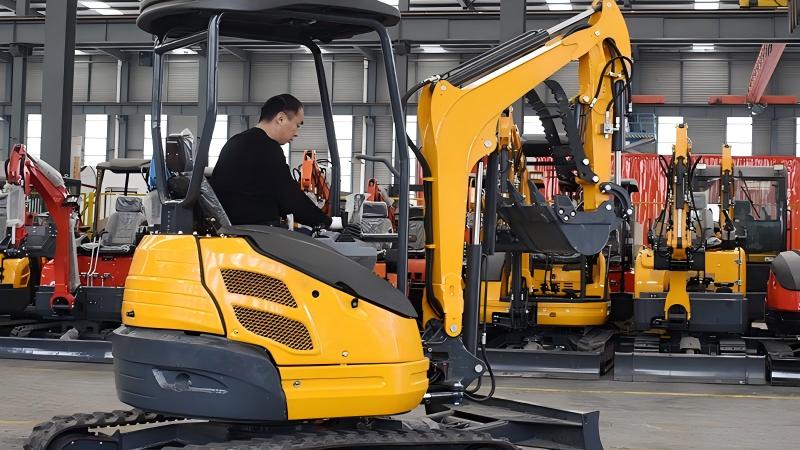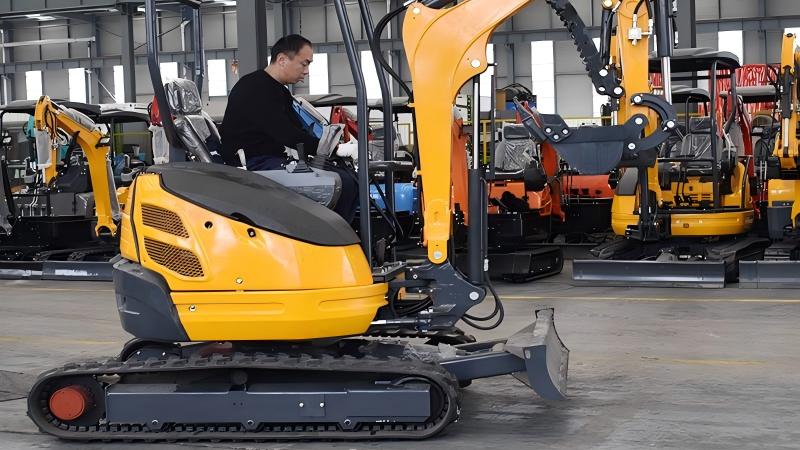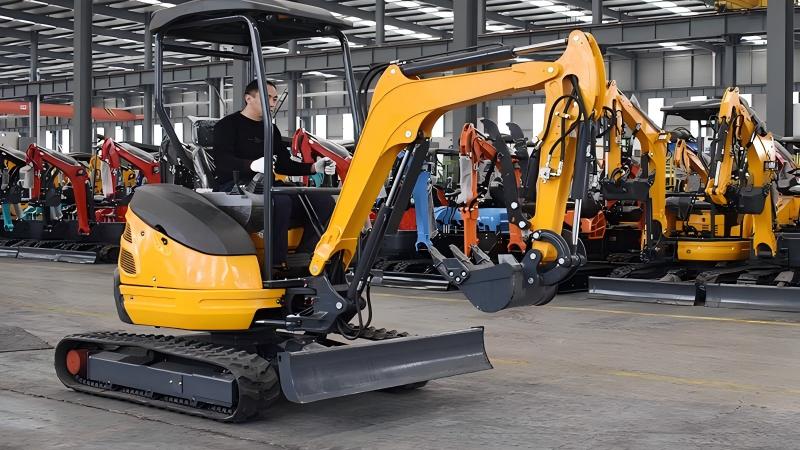Understanding Your Mini Excavator's Specifications
Before even thinking about transport, you must know the exact specifications of the mini excavator you intend to move. Key data points include:
Operating Weight: This is crucial. It determines the minimum Gross Vehicle Weight Rating (GVWR) required for your trailer and the towing capacity of your transport vehicle. Mini excavators can range from less than 1 ton (e.g., Kubota K008-3 at ~2,200 lbs) up to 8-10 tons (e.g., Cat 308 at ~18,000 lbs).
Dimensions (Length, Width, Height):
Width: The machine's width, especially with the tracks extended, will dictate the minimum width of your trailer bed and whether it will fit through gates, narrow roads, or underpasses.
Length: This includes the boom and dipper arm. You'll need to know the overall length when the boom is fully retracted and positioned for transport.
Height: The height of the machine, including the ROPS/canopy or cab, determines overhead clearance requirements. Some mini excavators have foldable ROPS for reduced transport height.
Ground Clearance: While not directly affecting transport dimensions, understanding the ground clearance is important for proper loading and unloading on ramps.
Attachment Weight: If you're transporting attachments (buckets, hydraulic breakers, augers), remember to factor their weight into the total load.
Choosing the Right Transport Equipment
The correct trailer and towing vehicle are the backbone of safe mini excavator transport.
The Trailer
Type: A flatbed trailer or a lowboy trailer (for larger mini excavators) is typically used. For smaller units, a tandem-axle utility trailer might suffice. The trailer must have sturdy, well-maintained ramps for loading and unloading.
Weight Capacity: The trailer's GVWR must exceed the total weight of the mini excavator plus any attachments and securing equipment. Overloading a trailer is extremely dangerous and illegal.
Deck Size: Ensure the trailer deck is wide and long enough to comfortably accommodate the excavator's footprint without overhangs that could be hazardous or illegal.
Braking System: The trailer must have functional brakes, especially for heavier loads. Electric brakes, surge brakes, or air brakes are common. Ensure your towing vehicle's brake controller is compatible.
Tie-Down Points: Look for multiple, strong tie-down points (D-rings, rub rails) on the trailer bed to secure the excavator properly.
Tires and Axles: Check tire pressure, condition, and tread depth. Ensure the axles are rated for the load.
Lights and Wiring: All trailer lights (brake lights, turn signals, running lights) must be in working order and connected properly to the towing vehicle.
The Towing Vehicle
Towing Capacity: The towing vehicle (truck) must have a towing capacity that exceeds the combined weight of the loaded trailer (trailer's empty weight + excavator weight + attachment weight). Exceeding the towing capacity can damage the vehicle, cause loss of control, and is illegal.
Hitch Type: Ensure the hitch (bumper pull, gooseneck, fifth wheel) is rated for the load and compatible with your trailer.
Brake Controller: For trailers with electric brakes, a properly installed and functioning brake controller in the towing vehicle is essential.
Tires: Ensure the towing vehicle's tires are properly inflated and in good condition, suitable for towing heavy loads.
Loading the Mini Excavator Safely
Loading is often the most hazardous part of the transport process.
Preparation:
Level Ground: Always load on flat, stable, level ground, away from traffic.
Clear Area: Ensure the loading area is free of debris, obstacles, and unauthorized personnel.
Check Ramps: Verify that ramps are securely attached to the trailer, clean, and free of oil, mud, or ice. Their angle should not be too steep for the excavator's ground clearance.
Secure Trailer: Chock the trailer wheels to prevent movement. If possible, disconnect the trailer from the towing vehicle and support the tongue jack. This prevents the towing vehicle's suspension from affecting stability during loading.
Excavator Inspection: Perform a quick walk-around of the excavator. Check tracks, fluids, and overall condition.
Loading Procedure:
Align: Carefully align the excavator with the ramps.
Slow and Steady: Drive the excavator slowly and deliberately up the ramps. Maintain a straight line.
Boom Position: Load with the heaviest part of the machine (typically the engine side) facing uphill on the ramps for better stability. If driving the excavator forward up the ramps, curl the bucket in and keep the boom low. If reversing, keep the boom tucked in and low.
Center of Gravity: Once on the trailer, position the excavator so its weight is distributed evenly over the trailer axles. The boom and stick should be lowered over the trailer's front, or tucked in tightly, to achieve a good weight distribution and minimize overall length and height.
Lower Attachments: Lower the bucket or blade to rest on the trailer deck. This prevents swinging and adds stability.
Retract Undercarriage: If the excavator has a retractable undercarriage, ensure it is in its narrowest (retracted) position to fit within the trailer width and avoid damage.
Securing the Mini Excavator for Transport
This step is absolutely critical to prevent movement during transit.
Lower Attachments: Lower the boom, stick, and bucket to rest on the trailer deck. Lower the blade to the deck as well.
Relieve Hydraulic Pressure: Follow the manufacturer's guidelines to relieve hydraulic pressure in the cylinders. This prevents "creeping" during transit.
Engage Parking Brake: Apply the excavator's parking brake.
Tie-Down Points: Use a minimum of four tie-down points for the main body of the excavator, securing each corner. Heavy-duty chains and binders (or straps rated for the load) are typically used. Ensure chains/straps are routed to prevent rubbing against hydraulic hoses or other vulnerable components.
Cross-Anchoring: Ideally, use cross-anchoring, where a chain from the front left of the excavator goes to the rear right of the trailer, and vice-versa. This prevents both forward/backward and side-to-side movement.
Additional Tie-Downs: Secure the boom, stick, and any loose attachments separately. The bucket can often be chained to the trailer deck.
Chain/Strap Rating: Ensure all chains, binders, and straps are rated for the weight they are securing. Overloading tie-downs can lead to failure.
Protective Padding: Use padding (e.g., old tires, rubber mats) between chains and the excavator's frame or painted surfaces to prevent damage.
Remove Loose Items: Secure or remove any loose items from the excavator, such as tools, keys, and personal belongings.
Pre-Trip Inspection and During Transit
Before hitting the road, conduct a thorough pre-trip inspection.
Lights: Check all trailer lights (running, brake, turn signals).
Tires: Verify tire pressure on both the towing vehicle and trailer. Inspect for cuts or bulges.
Tie-Downs: Double-check all chains and binders for tightness. Tug on them to ensure no slack.
Clearance: Check for adequate ground clearance and overhead clearance.
Permits: Confirm you have any necessary oversize load permits or special endorsements for your driver's license, depending on the weight and dimensions in your region.
Route Planning: Plan your route to avoid low bridges, tight turns, or roads with weight restrictions.
Driving:
Reduced Speed: Drive slower than usual, especially around corners and on uneven terrain.
Increased Braking Distance: Account for the significantly increased braking distance due to the heavy load.
Regular Checks: Stop periodically (e.g., every 50 miles or after the first 15-20 minutes) to recheck all tie-downs for tightness. Chains can sometimes loosen during the initial part of a journey.
Awareness: Be extra vigilant for other vehicles, especially when changing lanes or turning.
Unloading
Unloading is essentially the reverse of the loading process, but equally critical for safety.
Level Ground: Again, choose a flat, stable, level area.
Clear Area: Ensure the area is clear of people and obstacles.
Secure Trailer: Chock the trailer wheels.
Remove Tie-Downs: Carefully remove all chains and straps.
Slow and Steady: Drive the excavator slowly and deliberately down the ramps. Maintain a straight line. Keep the boom low and bucket curled, or blade down, for stability.
Move Away: Once off the trailer, move the excavator to a safe working area, away from the transport route.
Conclusion
Transporting a mini excavator is a task that demands careful attention to detail and adherence to safety protocols. From understanding the machine's specifications and choosing the right transport equipment to meticulous loading, securing, and driving practices, every step plays a vital role in ensuring a safe and successful move. By following these guidelines, operators and companies can confidently and efficiently transport their mini excavators to where they are needed, ready for action. Ignoring any of these steps can lead to costly equipment damage, serious injuries, or even fatalities. When in doubt, it's always best to consult the excavator's operator manual or hire a professional heavy haulage service.
Post time:Sep-25-2020



